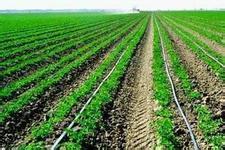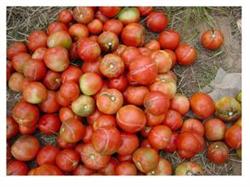Tomato late blight

Tomato late blight, which is called persimmon blight by vegetable farmers, is a destructive disease of tomato. -symptom recognition can occur in both seedling and adult stage. When the seedlings fell ill, the leaves appeared dark green flooding spots, which quickly expanded to the petiole and stem, making it thinner and dark brown, causing the whole plant to wilt or fold. When the humidity is high, there is white mold on the surface of the disease. The disease occurs in the adult stage, which mainly harms the leaves and fruits. Leaf disease, mostly from the leaf tip or leaf edge of irregular dark green water-immersed disease spots, and then turn brown. On rainy days or high humidity, the disease develops very rapidly, rapidly extending to half-leaf or whole-leaf, and a white mildew layer grows at the junction of disease and health at the edge of the spot, which is called "mildew wheel", and the diseased leaf decays quickly. When the disease is drier, the disease stops developing, and the disease is bluish white, dry, brittle and fragile. The disease spot on the stem is dark brown, slightly sunken, the edge is not clear, a little white mold grows when the humidity is high, and finally the epidermis decays, the plant is easy to bend from the rot part of the disease, and the fruit is mostly caused by green fruit. large irregular hungry brown moire spots are produced on the fruit surface, and sparse white mildew grows on the edge of the disease spot when the humidity is high. The diseased fruit is hard and does not rot in the initial stage, but rotten in the later stage. -the pathogen is called pathogenic Phytophthora, which belongs to the subphylum flagellum. The mycelium of the pathogen is fine, colorless and unseparated. Sporangium pedicel single or clustered by stomata protruding, slender, with nodular enlargement on branches, lateral or terminal sporangium. Sporangia monospore, colorless, ovate or lemon-shaped, with a papillary process at the top. Phytophthora infestans can also harm potatoes. But the pathogens on tomato and potato belong to different physiological races. The pathogen of the disease mainly overwintered in the soil with the disease residue of the mycelium, and it could also be damaged and overwintered on the tomato cultivated in greenhouse in winter, which became the source of primary infection in the following year. Tomato can also be infected by late blight on potatoes cultivated in spring. The overwintering pathogen produced sporangia, which was caused by Rain Water splashing on the lower leaves and fruits of the plant, forming a central diseased plant. After the diseased plants were formed in the field, a large number of sporangia were produced from the central diseased plants, which were spread by airflow and Rain Water, so that the disease spread rapidly. The sporangia germinated in 2 hours under suitable temperature and humidity, invaded by stomata or directly through the epidermis, and the incubation period was 3-4 days. Therefore, once the central diseased plant appeared in the field, the tomato disease would be common in more than 10 days. -bacteria prefer lower temperature and high humidity conditions. The growth temperature range of the pathogen is 10-25 ℃, the optimum temperature is about 20 ℃; the sporangium formation temperature range is 7-25 ℃, the optimum temperature is 18-20 ℃, the sporangium germination produces zoospore temperature range of 6-15 ℃, the optimum temperature is 10-13 ℃, and the relative humidity is more than 85%. The sporangium peduncle can be produced, and the sporangium can be formed only at 95-97%. There must be water droplets in sporangia germination. therefore, lower temperature and higher humidity are important conditions for the disease, especially whether there are saturated relative humidity or whether there are water droplets on the leaf surface is the decisive condition for the disease. Sooner or later in the field, the disease develops quickly, which is directly related to the morning and night rainfall and the amount of rainfall. Generally, the temperature is not more than 24 ℃ in day and night, cool at night but not less than 10 ℃ at night, heavy fog in the morning and evening, or cloudy and rainy days in the morning and evening. When the relative humidity is 75-100% for a long time, late blight will be a pandemic. In cultivation, diseases are easy to occur because of low-lying terrain, poor drainage, dense plants and untimely construction. The excessive growth of plants caused by partial application of nitrogen fertilizer, or the growth failure of barren plants in soil will reduce the resistance to the disease, and aggravate the occurrence of the disease, and there are differences in disease resistance among tomato varieties. -Control measures-(1) planting disease-resistant (tolerant) varieties. -(2) rotation with non-Solanaceae vegetables for more than 3 years. -(3) the cultivation is not easy to be too dense, set up the frame as soon as possible, prune in time, properly remove the lower old leaves of the plant, and improve the ventilation and light transmission conditions. -(4) Tomato in the protected field should control the water properly in the early stage, release the air in time after the weather turns warm, and gradually increase the amount of air release, reduce the humidity in the protected area, and control the occurrence of late blight. -(5) Pesticide control. -(6) grafting: DW21-1 tomato hybrid special rootstock can be selected, which can not only increase the plant disease resistance, but also greatly improve the yield and economic benefits.
- Prev

Irrigation Management Technology of Tomato planting
After the tomato seedlings are squatted (the first fruit is about the size of a walnut), the tomato is watered with 3 murmur4 water during the whole growth period. Generally, the seedlings are watered once at the seedling stage, and the water is controlled until the first ear expands to the straight stem of the young fruit at 2Mui 4cm. After that, depending on the moisture content of the seedling, it is irrigated every 15 days, and irrigated for 4 times during the whole growth period, each time.
- Next

Coping techniques of Tomato Fruit cracking
First, strengthen the management of water and fertilizer. The root system of the plant grew well by ploughing the soil deeply and applying more organic fertilizer. When the temperature of tomato falls sharply after autumn, we should pay more attention to the management of soil moisture to avoid the rapid change of soil moisture. When cultivating in open field, we should water more at ordinary times to avoid drastic changes in soil moisture when it rains suddenly, and drain it in time after rain.
Related
- Where is it suitable to grow horseradish in China? it is expected to see the middle altitude horseradish in Alishan.
- How to prevent tomato virus disease reasonably? (Control methods included)
- Many people like to plant towel gourd on the balcony. What are the main points of this method and management?
- What crops can chili peppers be mixed with?
- Fertilization techniques and matters needing attention in Tomato
- What are the grafting techniques for peach seedlings in spring?
- Harm and control methods of root swelling disease of Chinese cabbage
- What are the pests of sweet potatoes? How to prevent and cure it?
- Symptoms, causes and Control methods of navel Rot in Tomato
- The cause of "Cucumber rotten bibcock" in Farmers' planting Cucumber and its Control Plan

